Lately I’ve been having a lot of conversations around investment terms with searchers, as well as investors.
About 15 years ago, I interned at a search fund. And, over the last few years, I’ve started to invest in the asset class going direct as well as through funds of search funds.
Investing in search funds is a great way to scratch my entrepreneurial itch, extremely rewarding when a searcher finds success, and can be economically rewarding too.
This post is my attempt to share thoughts on self funded search economics in an effort to contribute to the search fund community, get feedback on my thinking from a wider audience, and of course meet more people who are doing searches/investing and may want to collaborate (please feel free to reach out!).
You can watch a video of me explaining this model here, and download the excel here:

Enterprise Value
The standard finance equation is enterprise value = debt + stock – cash. Enterprise value is how much the company itself is worth. Many times people confuse it with how much the stock is worth and find the “minus cash” part of this really confusing.
So, you can rearrange this equation to make it stock = enterprise value – debt + cash. Make more sense now?
Enterprise value is just how much you’re willing to pay for the company (future cash flows, intellectual property, etc), not the balance sheet (debt and cash).
Most investors and searchers think about the EBITDA multiple of a company on an enterprise value basis because they’ll be buying it on a cash free, debt free basis. It becomes second nature to think about EBITDA multiples and know where a given business should fall given scale, industry, etc.
However, I believe this second nature way of thinking of things can be a massive disadvantage to investors given the way EV and multiples are talked about in our community currently.
Sources of capital, the typical way to calculate enterprise value for self funded searchers
If you’ve ever looked at or put together a teaser for a self funded search deal, you will notice that the deal value is equal to the sum of the sources of capital minus deal fees and cash to the balance sheet.
As a simple example, if there is $4 mm of debt to fund the deal, $1 mm of equity, and $200k of deal fees, the enterprise value = $4 mm + $1 mm – 200k = $4.8 mm.
We’ll use slightly more complex numbers in our example: If a searcher is taking a $3.2 mm SBA loan, $850k seller note, putting in $120k themselves, getting $350k of equity from the seller, a $500k earnout, and $1.2 mm of equity financing minus $350k to the balance sheet and $250k of deal fees, then the enterprise value will be $5.62 mm.
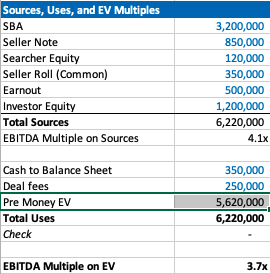
Our example company has $1.5 mm of EBITDA, so the EBITDA multiple is 3.7x. This is a pretty attractive acquisition multiple for a business that meets traditional search criteria (recurring revenues, fragmented competition, high gross margins, low customer concentration, etc).
If you’re seeing a search fund deal for the first time, the headline of “we’re buying a decent company for 3.7x, and replacing a tired owner with a hungry operator” is pretty exciting!
However, if you’re an investor, there is some nuance to this enterprise value number and the true EBITDA multiple you are investing in.
The trick with self funded enterprise value
The security that most self funded search investors get in a deal is participating preferred stock with a paid in kind dividend. This means when there’s an exit, you get your money back before any other equity holder, then get a certain percent of the business, and whatever dividend you’ve been owed in the interim accrues to your principle.
It’s a really favorable security for the investor, and one that is basically impossible to get in VC where straight preferred stock is much more common (no pun intended).
The key terms are what percent of common equity does this security convert into after the originally principal is paid back, and what is the dividend.
The share of common equity the investor group will get typically ranges from 10-50% of the total common stock. The dividend rate is usually 3-15%. The average I’m seeing now is around 30% and 10% for common and dividends respectively.
The strange this about the enterprise value quoted to investors in a teaser/CIM is that it doesn’t change as the percent of common changes, even though this has large implications for how much the common equity is worth and the value investors receive.
For example, I may get a teaser where the sources of investment – cash to balance sheet – deal fees = $3.7 mm for a $1 mm EBITDA company, which would imply a 3.7X EBITDA multiple. Let’s say the searcher is offering investors 30% of the common and a 10% dividend.
Let’s now say that the searcher is having a tough time raising capital and changes their terms to 35% of common and a 12% dividend. Does the effective enterprise value change for investors? I would argue yes, but I would be surprised to see it changed in the CIM/teaser.
This isn’t a knock on searchers or the search fund community. It’s just kind of how things are done, and I think this is mostly because it’s really hard to think about how the enterprise value has changed in this scenario.
However, the natural way of using EBITDA multiples to think about value for a business that is so common in PE/SMB can be extremely misleading for investors here. You may be thinking 3.7X for this type of business is a great deal! But, what if the security you’re buying gets 5% of the common?
If you’re in our world, you may counter this point by saying most searchers will also supply a projected IRR for investors in their CIM. However, IRR is extremely sensitive to growth rate, margin expansion, and terminal value. While the attractiveness of the security will be reflected, it can be greatly overshadowed by lofty expectations.
To get more clarity and have a slightly different mental model on the effective price investors are paying for this business, let’s go back to basics. Enterprise value should be debt + preferred stock + common stock – cash.
We know the values of each of these numbers, except the common. So, the main question here becomes: how much is the common equity worth?
Calculating value of common equity for self funded search funds
Equity value for most search fund deals = preferred equity from investors + the common equity set aside for the searcher and sometimes also advisors, board, seller.
We know that the preferred equity is investing a certain amount for a certain amount of common equity. The rub is that they are also getting a preference that they can take out before any common equity gets proceeds, and they are getting a dividend.
So, the exercise of valuing the common equity comes down to valuing the preference and dividend.
In my mind, there are three approaches:
- The discount rate method where you take the cash flows you’ll get in the future from the pref/dividends and discount them back at the discount rate of your choice. I am using 30% in my model which I believe accurately compensates investors for the risks they are taking in a small, highly leveraged investment run by an unproven operator. If you believe in efficient markets, this number also fits as it mirrors the historical equity returns as reported by the Stanford report, with a slight discount given this asset class has clearly generated excess returns relative to other assets on a risk adjusted basis, hence interest in these opportunities from an expanding universe of investors.
- The second method is to calculate how much money you’d get from your preference and dividends, taking into account that per the Stanford study around 75% of search funds will be able to pay these sums, and then discount these cash flows back at a rate more in line with public equities (7% in my model). This yields a much higher value to the preference/dividend combo, and therefore lowers the implied value of the common equity.
- The last method is to just say nope, there is no value to the preference and dividend. I need them and require them as an investor, but they are a deal breaker for me if they aren’t there, and therefore they don’t exist in my math. This of course makes no logical sense (you need them, but they also have no value?), but I’ve left it in as I think many investors probably actually think this way and it creates a nice upper bound on the enterprise value. Side note, as with obstinate sellers, jerk investors are usually best avoided.
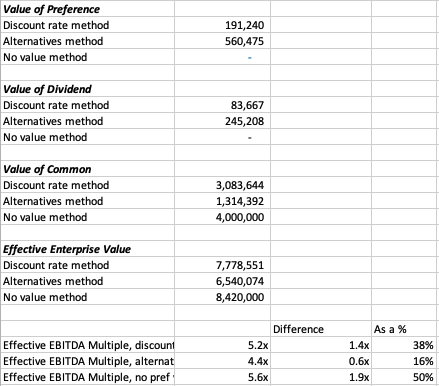
In our example, you can see a breakdown of the preference value, dividend value, and therefore common value and enterprise value for this deal.
In each case, the effective EBITDA multiple moves from 3.7x to something much higher (see the last 3 lines).
There are some simplifying assumptions in the model (no accruing dividend, all paid in last year), and some weird stuff that can happen (if you make the hold time long and the dividend greater than the 7% equity discount rate, the value of the dividend can get really big).
These flaws aside, I think this creates a nice framework to think through what the common is actually worth at close, and therefore what enterprise value investors will be paying in actuality.
It’s worth noting that the whole point of this is to benchmark the value you’re getting relative to market transactions in order to understand where you want to deploy your capital.
This creates a method to translate cash flow or EBITDA multiples of other opportunities on an apples to apples basis (if only there were a magical way to translate the risk associated with each as well!).
Another note, we could calculate the value of the common to be what this asset would trade at market today in a well run auction process minus any obligations (debt, preference, seller financing). However, I think that understates the option value inherent in this equity, a value that is only realized when a new manager takes over with more energy and know how.
There is a finance nerd rational for this. If you plot the value of equity in a leveraged company on a chart, it mirrors the payout of a call option. In both cases, the value of the security increases at a certain inflection point: when the value of equity rises above the strike price in an option, and when the enterprise value of a company rises above the debt level in a levered company.
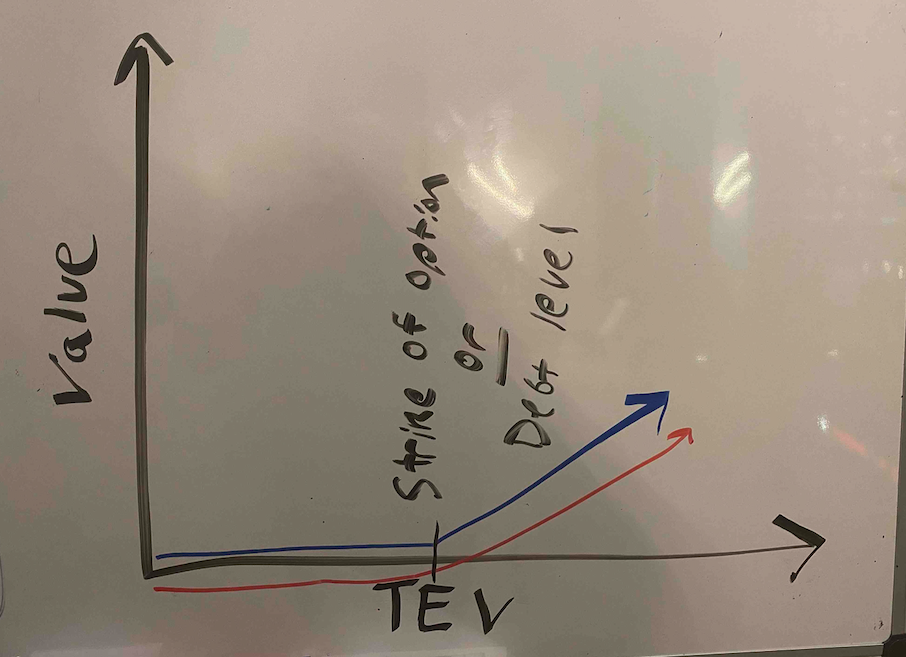
The common equity of a highly levered company can therefore be valued by a similar methodology as the call option: Black Scholes. If you remember back to finance class, increasing volatility will increase the value of an option.
In the search fund case, we’ve (hopefully) increased the (upside) volatility and therefore create more value than simply selling the company today.
A few more thoughts on investor economics
There are a few other ways to think about the economics you get as an investor to best understand if this is the deal for you.
First, you may want to think about how much your investment will be worth day 1. The key lever in this model is what discount this company is being bought for relative to fair market value. For example, the searcher may have proprietary sourced a great company and is buying it for 25% below what it would trade at in a brokered auction.
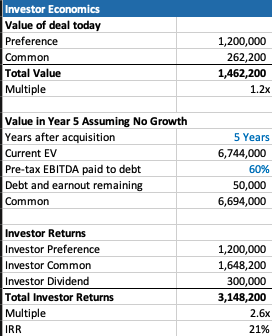
This is very much a “margin of safety” philosophy on things. Same with the calculation on how much you’ll receive in year 5 (after QSBS hits) assuming no growth in the business.
The only problem with each of these calculations is that they never play out in practice. Most companies don’t just stay the same, you’re either in a rising tide or you’re in trouble. And, you’re almost never going to sell in year 1, and definitely not for a slight premium to what it was bought for.
However, if your investment is worth 30% higher day one, and you can make a 20% IRR assuming nothing too crazy happens either way in the business, that’s not a bad place to start. Add in a strong searcher, decent market, some luck, and you’re off to the races.
Thoughts on searcher economics
A lot of this post has considered things from the investor perspective as my main quandary was related to how to create an EBITDA multiple that made sense for investors.
However, the point of this post is not to say searchers are misrepresenting or being unrealistic with their terms. In fact, I think it’s quite logical that self funded searchers capture the massive economic value that they do.
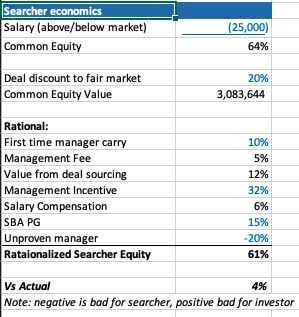
There are many reasons why self funded searchers deserve the lion share of the common equity.
First, they are providing a nice service of giving investors a positive expected value home to park their money with much lower correlation to the market than other asset classes ($1 mm EBITDA companies don’t see lots of multiple contraction/expansion throughout cycles).
Most money managers that fit that criteria are taking a 2/20, of course they also usually have a track record. So, I’ve used a 10% carry in my model, but stuck to 2% annual management fee.
The searcher spent a lot of time, and probably money, finding this company. That’s a lot of value, especially if it’s a below market price. They should be able to capture a lot of the value in finding a below market deal.
The searcher may be taking a below market salary, and needs to get comped like any CEO, with stock options. In my example model I have $1 mm of stock vesting over the hold period, as well as extra comp for taking a below market salary.
Searchers are also usually putting their financial standing at risk by taking a personal guarantee on the bank/SBA loan. This is really tough to put a number on, as is the last line in my framework where searchers are dinged for lack of experience. Like any good model, you need a few lines that you can fudge to make the math work 🙂
What you do think?
I’m shocked that I wrote all this. I was going to type a few paragraphs and a quick excel. However, putting this to paper has been a great exercise for me to sharpen my thinking.
Now I’d like you to help me further. Where do you think this should be changed in this framework? How do you think about things from the investor and/or searcher side?
Feel free to shoot me a note if you have thoughts (even just to tell me I’m being way too academic with this, which I actually agree with).
Lastly, a post like this is really a trap I’m putting on the internet to catch any like minded people in so that we can figure out ways to collaborate now or in the future. So, at the very least, connect with me on LinkedIn 🙂
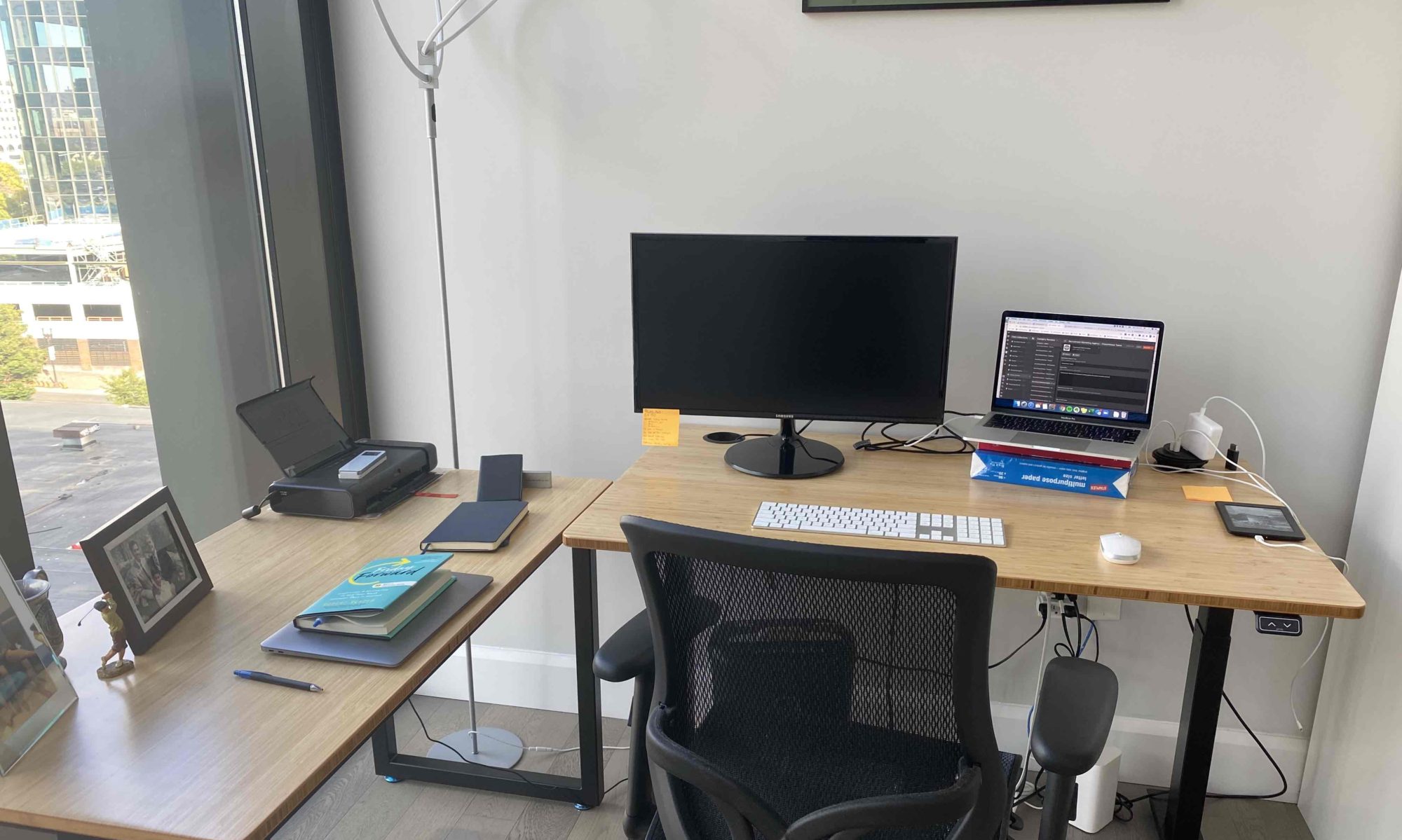
I could not refrain from commenting. Exceptionally well written!
Its like you read my mind! You seem to know a lot about this, like you wrote the book
in it or something. I think that you can do with a few pics
to drive the message home a little bit, but instead
of that, this is wonderful blog. A great read. I will certainly be back.
Wow, this article is nice, my sister is analyzing such
things, so I am going to let know her.
I’m extremely impressed with your writing skills as well as with the layout on your blog.
Is this a paid theme or did you customize it yourself?
Either way keep up the nice quality writing, it is rare to see
a nice blog like this one today.
Thanks for sharing your thoughts about https://www.fhwa.dot.gov/reauthorization/reauexit.cfm?link=https://notes.io/PAxh. Regards
Way cool! Some extremely valid points! I appreciate you penning this article and the rest of the site is very good.
If you are going for best contents like me, only go to see this web site all
the time for the reason that it offers quality contents, thanks
Pretty section of content. I just stumbled upon your site and in accession capital to claim that I acquire actually enjoyed account
your blog posts. Any way I will be subscribing to your feeds and even I success you get right of entry to constantly quickly.
Heya i’m for the first time here. I found this board and I find It really useful & it helped me out much.
I hope to give something back and aid others like you aided
me.
I for all time emailed this weblog post page to all my associates,
as if like to read it next my contacts will too.
Undeniably believe that which you said. Your favorite reason seemed to be on the internet the easiest thing to be aware of.
I say to you, I definitely get annoyed while people consider worries
that they plainly do not know about. You managed to hit the nail upon the top
and also defined out the whole thing without having side-effects
, people could take a signal. Will likely be back to get
more. Thanks
This information is priceless. How can I find out more?
This is very interesting, You are a very skilled blogger.
I’ve joined your rss feed and look forward to seeking more
of your wonderful post. Also, I have shared your site in my social networks!
This is a great tip particularly to those new to the blogosphere.
Brief but very precise info… Thanks for sharing this one.
A must read article!
Hi, I do think this is an excellent site. I stumbledupon it ;
) I will come back once again since I saved as a favorite it.
Money and freedom is the best way to change, may you be rich and
continue to help others.
Magnificent goods from you, man. I’ve understand your stuff previous to and you’re just extremely great.
I really like what you have acquired here, certainly
like what you are stating and the way in which you say it.
You make it enjoyable and you still take care of to keep it wise.
I can not wait to read much more from you.
This is actually a tremendous website.
Hi there it’s me, I am also visiting this website
on a regular basis, this web site is in fact fastidious and the visitors are really sharing fastidious thoughts.
It’s going to be finish of mine day, however before
end I am reading this great piece of writing to increase my
know-how.
Hey there! I’m at work surfing around your blog from my new iphone 3gs!
Just wanted to say I love reading through your blog and look forward to all
your posts! Carry on the superb work!
It’s remarkable to pay a quick visit this web page
and reading the views of all colleagues concerning this piece of writing, while
I am also keen of getting familiarity.
Wow that was unusual. I just wrote an very long comment but after I clicked
submit my comment didn’t appear. Grrrr… well I’m not writing all that
over again. Regardless, just wanted to say superb
blog!
Write more, thats all I have to say. Literally, it seems as though you relied on the video
to make your point. You obviously know what youre talking about, why waste your intelligence on just posting videos
to your site when you could be giving us something informative to read?
I am curious to find out what blog system you happen to be using?
I’m experiencing some small security problems with my
latest website and I would like to find something more risk-free.
Do you have any solutions?
I’ve been surfing online more than 3 hours today, yet I never found any interesting article like yours.
It is pretty worth enough for me. Personally, if all site owners and bloggers
made good content as you did, the net will be a lot more useful than ever before.
Fantastic blog you have here but I was wanting to know if
you knew of any forums that cover the same topics talked about in this article?
I’d really like to be a part of online community
where I can get feedback from other experienced individuals that
share the same interest. If you have any recommendations,
please let me know. Thank you!
Hi, just wanted to mention, I loved this post.
It was practical. Keep on posting!
Greetings, There’s no doubt that your blog could be
having browser compatibility problems. Whenever I look at your blog in Safari, it looks fine however, if opening in Internet Explorer, it’s got some overlapping issues.
I just wanted to give you a quick heads up! Besides that, wonderful site!
I seriously love your website.. Very nice colors & theme.
Did you make this website yourself? Please reply back as I’m trying
to create my very own site and want to know where you got this from
or just what the theme is called. Appreciate it!
Actually when someone doesn’t be aware of afterward its up to other people that they will assist, so here it takes place.
I enjoy what you guys are up too. This sort of clever work and coverage!
Keep up the wonderful works guys I’ve added you guys to our blogroll.
This info is priceless. How can I find out more?
I read this article fully about the comparison of latest and earlier technologies, it’s amazing article.
Thank you for the good writeup. It in fact was a amusement account it.
Look advanced to more added agreeable from you!
However, how could we communicate?
I’d like to thank you for the efforts you have put in penning
this site. I am hoping to see the same high-grade content by you later on as well.
In truth, your creative writing abilities has encouraged me to get my very own blog now 😉
An interesting discussion is definitely worth comment.
I do believe that you should write more about
this topic, it might not be a taboo matter but usually
folks don’t talk about such topics. To the next! All the best!!
Do you have a spam problem on this site; I also am a blogger, and I was curious about
your situation; many of us have created some nice procedures and we
are looking to swap methods with others, be sure to shoot me
an e-mail if interested.
Hey there! I know this is kind of off topic but I was wondering which blog platform are you using for this site?
I’m getting tired of WordPress because I’ve
had problems with hackers and I’m looking at alternatives for another platform.
I would be fantastic if you could point me in the direction of a good platform.
Hi there, I discovered your website by the use of Google at the same
time as looking for a related matter, your site got here up, it appears good.
I have bookmarked it in my google bookmarks.
Hello there, simply was aware of your weblog
through Google, and located that it’s truly informative.
I am going to be careful for brussels. I will be grateful in the event you proceed this in future.
Many other people will likely be benefited out of your writing.
Cheers!
Whats up this is somewhat of off topic but I was wanting to know if blogs use WYSIWYG editors or if you
have to manually code with HTML. I’m starting a blog soon but have
no coding knowledge so I wanted to get advice from someone with experience.
Any help would be greatly appreciated!
I think this is one of the most important info for
me. And i am glad reading your article. But want
to remark on few general things, The web site style is perfect, the articles is really excellent :
D. Good job, cheers
Hey! I know this is somewhat off topic but I was wondering if you
knew where I could find a captcha plugin for my comment form?
I’m using the same blog platform as yours and I’m having problems finding one?
Thanks a lot!
Hi! I could have sworn I’ve visited your
blog before but after browsing through many of the articles
I realized it’s new to me. Nonetheless, I’m definitely delighted I found it and I’ll
be bookmarking it and checking back regularly!
We’re a bunch of volunteers and starting a brand new scheme in our community.
Your web site provided us with valuable info to work
on. You’ve performed an impressive process and our whole community
can be thankful to you.
Fantastic website. Lots of helpful info here. I am sending it to a few buddies ans also sharing in delicious.
And of course, thank you on your effort!
Yesterday, while I was at work, my cousin stole my apple ipad and tested to see if it can survive
a thirty foot drop, just so she can be a youtube sensation. My
apple ipad is now broken and she has 83 views. I know this is totally off topic but I had to share it with someone!
Everything is very open with a really clear clarification of the
issues. It was definitely informative. Your website is useful.
Thanks for sharing!
This paragraph presents clear idea for the new people of blogging, that truly
how to do blogging and site-building.
It’s wonderful that you are getting ideas from this post as well as from our argument made here.
Do you have a spam issue on this site; I also am a blogger,
and I was wondering your situation; we have created some nice practices and we are looking to exchange
methods with others, please shoot me an email if interested.
Its like you read my mind! You seem to know a lot about this, like you wrote the book in it or something.
I think that you could do with some pics to drive the message home a bit, but other
than that, this is magnificent blog. An excellent
read. I’ll certainly be back.